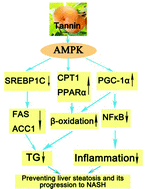Persimmon Tannin accounts for hypolipidemic effects of persimmon through activating of AMPK and suppressing NF-κB activation and inflammatory responses in High-Fat Diet Rats†
Abstract
The present study was to investigate whether high molecular weight persimmon tannin (HMWPT) is the main component associated with the anti-hyperlipidemic effect of consuming persimmon and its underlying mechanism. Male wistar rats were given a basic diet (control), a high-fat diet, a high-fat diet plus 0.5% of HMWPT or 4.2% of lyophilized fresh persimmon fruit (with the same diet HMWPT content in the two groups) for 9 weeks. Administration of HMWPT or persimmon fruit significantly (p < 0.05) lowered serum triglycerides and free fatty acids, enhanced the excretion of triglycerides, cholesterol and bile acids, and improved hepatic steatosis in rats fed a high-fat diet. Dietary HMWPT or persimmon fruit significantly decreased the protein levels of fatty acid synthase (FAS), and stimulated AMP-activated protein kinase (AMPK) phosphorylation and down-regulated genes involved in lipogenesis, including transcriptional factor sterol regulatory element binding protein 1 (SREBP1) and acetyl CoA carboxylase (ACC). In addition, the expression of proteins involved in fatty acid oxidation, such as carnitine palmitoyltransferase-1 (CPT-1), was notably up-regulated. Furthermore, HMWPT and persimmon fruit suppressed inflammatory cytokines such as tumor necrosis factor α (TNFα) and C-reactive protein (CRP) and the protein level of nuclear factor-kappa B (NFκB) in the liver. Taken together, our findings demonstrated that HMWPT reproduced the anti-hyperlipidemic effects of persimmon fruit, and was a pivotal constituent of persimmon fruit accounting for prevention of liver steatosis and its progression to nonalcoholic steatohepatitis (NASH) by activation of the AMPK and regulation of its downstream targets, suppressing NF-κB activation and inflammatory responses, and inhibiting lipids and bile acid absorption.


 Please wait while we load your content...
Please wait while we load your content...